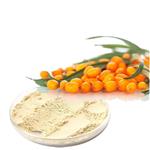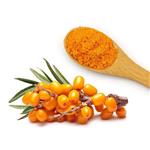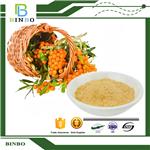Sea buckthorn, Hippophae rhamnoides, ext.
- Product NameSea buckthorn, Hippophae rhamnoides, ext.
- CAS90106-68-6
- MF
- MW0
- EINECS290-292-8
- MOL FileMol File
Usage And Synthesis
Sea buckthorn is a plant endemic to Asia and Europe, mainly distributed in the temperate and cold temperate zones of Eurasia, from Nepal and India on the southern slope of the Himalayas in the south to Scandinavia and Norway on the Atlantic coast in the north, to Inner Mongolia in the east, to Spain in the Mediterranean in the west, and also in the cold temperate zones of the North American continent. Among them, the most concentrated are the European continent, China's Qinghai-Tibet Plateau and Altai Mountains, and Russia's Siberia region.
Sea buckthorn (Hippophae rhamnoides L.) is a deciduous shrub of the family sea buckthorn. According to textual research, it has lived on the earth for about 200 million years. It was discovered by the ancient Greeks in 5000 BC and could be fed to racehorses. In the 8th century AD, Tibetans used sea buckthorn as a medicine to treat lung diseases and stomach diseases. In the 12th century AD, Mongolians used sea buckthorn as a sacred food, calling it "the emperor's painstaking efforts" for medical treatment and food. At present, more than 20 countries all over the world are promoting and utilizing sea buckthorn. Sea buckthorn ranks first among the top ten raw materials of health products, as announced by the World Health Organization[1].
Sea buckthorn tree has good resistance to dry and cold, salt and alkali, and barren, so its vitality is very strong and can withstand extreme temperatures of -40?40 °C. The height of sea buckthorn is generally 1.5 m, but it may be higher if it grows in high mountains and valleys. Sea buckthorn has many thorns; its tender branches are brownish green, its dense quilt is silvery white, and its old branches are grayish black and rough. Usually, sea buckthorns begin to bear fruit at 3 years and enter the full fruit period at the age of 5 years, which lasts for about 4?5 years. The fruit yield of sea buckthorn per plant varies greatly with different regional conditions, and the fruit yield of sea buckthorn per plant is 2?5 kg during the fruit-bearing period.
[1] Aruhan Chen . “Traditional food, modern food and nutritional value of Sea buckthorn (Hippophae rhamnoides L.): a review.” Journal of Future Foods 3 3 (2023): Pages 191-205.
[2] Dubey, Roshan Kumar et al. “Sea buckthorn: A Potential Dietary supplement with multifaceted therapeutic activities.” Intelligent Pharmacy 89 (2023).
[2] Dubey, Roshan Kumar et al. “Sea buckthorn: A Potential Dietary supplement with multifaceted therapeutic activities.” Intelligent Pharmacy 89 (2023).
Sea buckthorn oil is extracted from the seeds and pulp of berries and is widely used in cosmetics and skincare products. It is rich in omega-7 fatty acids (palmitoleic acid). Sea buckthorn oil is rich in essential fatty acids, vitamins, and antioxidants that can nourish, moisturize, protect, and heal the skin. Sea buckthorn oil may help with acne, rosacea, sunburns, scars, wrinkles, dryness, and skin infections[2].
Preparation Products And Raw materials
Sea buckthorn, Hippophae rhamnoides, ext. Supplier
Tel +86-15532196582 +86-15373005021
Email lisa@kingfinertech.com
Related Product Information
- METHYL ISOCYANOACETATE
- Tosylmethyl isocyanide
- 1,1,3,3-TETRAMETHYLBUTYL ISOCYANIDE
- 2,4-PENTANEDIONE, SILVER DERIVATIVE
- COBALT(II) ACETYLACETONATE
- PHENYLSELENOL
- Tris(2,4-pentanedionato)chroMiuM(III)
- TERT-BUTYL ISOCYANIDE
- Ferric acetylacetonate
- Cupric acetylacetonate
1of4
PROMPT×
PROMPT
The What'sApp is temporarily not supported in mainland China
The What'sApp is temporarily not supported in mainland China
Cancel
Determine


